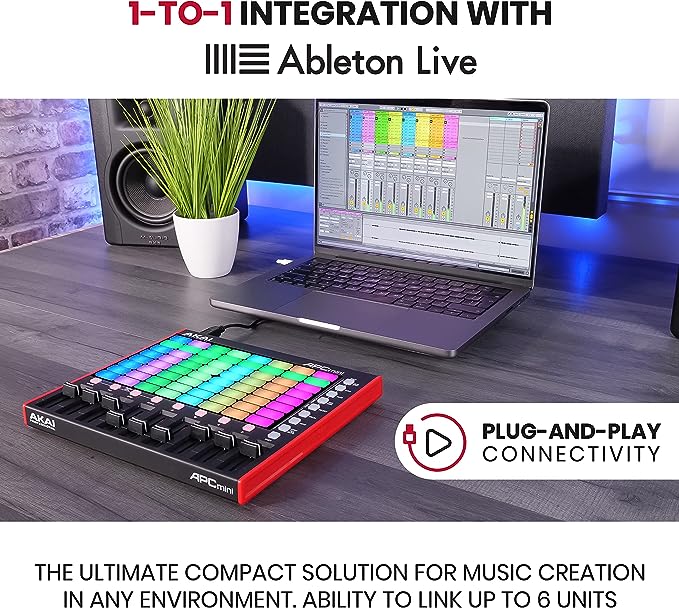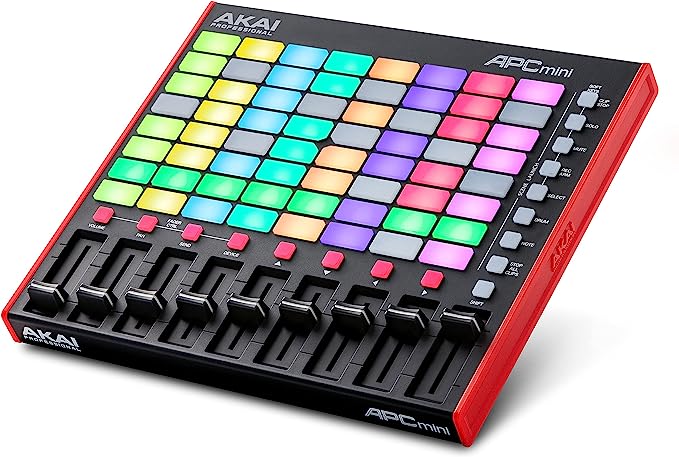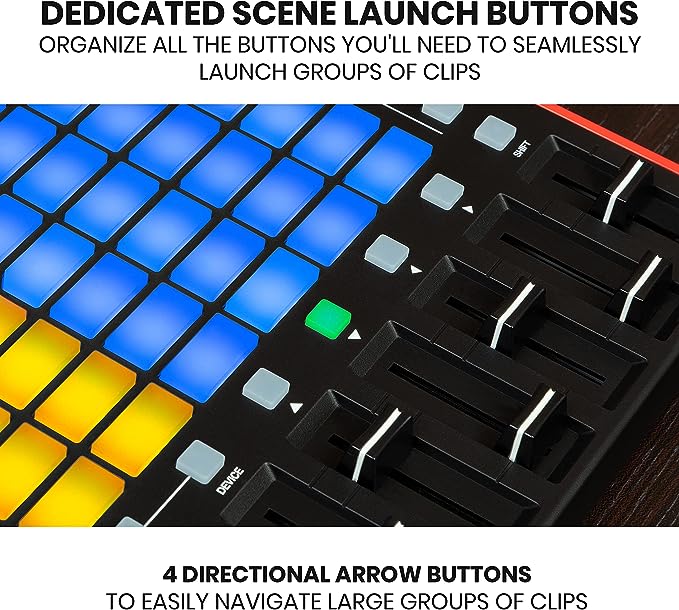AKAI MPK MINI MK2 OVERVIEW
The Akai MPK Mini MK2 is designed for musicians and producers who are always on the move. It has a compact size, slightly larger than a typical laptop, making it easy to slide into a backpack and carry anywhere conveniently. However, while convenience is important, it’s equally crucial to consider the performance and features of a production keyboard. What sets the Akai instrument apart in terms of performance, and how does it compare to other “laptop production keyboards” in its price range?
The Akai MPK Mini MK2 delivers impressive performance. It offers a range of features that make it a compelling choice within its price range. The keyboard has responsive keys and a versatile set of controls, including eight pads for triggering samples or programming beats. Additionally, it includes eight rotary knobs for controlling various parameters such as synth settings or software effects. The presence of an arpeggiator adds further creative possibilities to your compositions.
Compared to other “laptop production keyboards” in its price range, the Akai MPK Mini MK2 holds its ground. It strikes a good balance between portability and functionality, offering a comprehensive set of features despite its compact size. While there may be other options available, the Akai MPK Mini MK2 stands out as a reliable and versatile choice for musicians and producers who prioritize mobility without compromising on performance.
In summary, the Akai MPK Mini MK2 excels in performance, making it a worthy companion for musicians and producers on the go. Its compact and lightweight design, coupled with its impressive feature set, sets it apart from other keyboards in its price range. Whether you’re traveling or working in a confined space, the Akai MPK Mini MK2 offers the performance and convenience you need to create music wherever you are.


AKAI MPK MINI MK2 FIRST IMPRESSION
Upon initial inspection, the Akai MPK Mini MK2 bears a resemblance to larger production keyboards, albeit in a more compact form. Due to its smaller size, certain function buttons have been omitted to save space. Notably absent are the LED display, modulation wheels, and pitch bend. This trade-off is a consequence of creating a compact instrument, and it remains to be seen how this affects the overall performance of the keyboard.
The MPK Mini MK2 features eight assignable knobs, similar to those found on larger MPK models, along with a set of drum pads. The velocity-sensitive percussion pads are thick and durable, covered in heavy-duty rubber. They are black with translucent sides that allow backlights to illuminate whenever a pad is struck. Despite the compact size of the unit, the pads are still large enough for comfortable playing, minimizing the chances of accidentally hitting the wrong pad.
In fact, two index fingers can fit on a single pad, enabling simple “rolls” to be executed. While the Mini MK2 utilizes cost-saving materials, the quality of the pads remains satisfactory and may even outperform some pads found on larger and more expensive MPK controllers. Only users accustomed to the high-quality pads of premium MPK controllers may find these pads limiting.
The remaining buttons on the instrument share the same material as the percussion pads and are also equipped with backlighting, facilitating ease of use even in low-light conditions.
As for the knobs, they are standard pots without endless rotary encoders. Their caps are embossed with ridged patterns but can feel somewhat slippery. One issue with the knobs is their short height, barely extending a centimeter above the top panel, which can make them challenging to grip and control. However, some may view this as an advantage, as it reduces the risk of damage, considering that they are not as sturdy as desired.
A common drawback of compactly designed controllers is the tendency for function buttons to be positioned too closely together. This problem manifests when handling the knobs, as they are situated closely, making simultaneous tweaking of two parameters challenging. The best approach is to assign parameters to distant knobs to mitigate this issue.
In summary, the Akai MPK Mini MK2 sacrifices certain functions due to its compact design. While some features are omitted, such as the LED display and modulation wheels, the instrument still offers eight assignable knobs and durable percussion pads with backlights.
The knobs, though standard in design, may pose challenges due to their short height and close proximity to each other. Despite these limitations, the MPK Mini MK2 remains a viable option for those seeking a portable and space-saving production keyboard, particularly for users who prioritize convenience over advanced functionalities.
Installation
Setting up the Akai MPK Mini MK2 is a straightforward process. It is a plug-and-play keyboard that doesn’t require any special drivers to start functioning. The keyboard is compatible with both Mac and Windows operating systems and includes a software patch editor. While the manufacturer has not specified any minimum system requirements, it is expected that the keyboard should work properly with any recent PC.
Power for the Akai MPK Mini MK2 is supplied through a USB connection. You can use either the standard flat A-type USB or the mini B-type USB to connect it to your computer. The controller comes with a USB cable, so there is no need to purchase one separately. It’s worth noting that there is no power button on the controller. Once it is plugged into a power source, it will automatically turn on. The provided manual can guide you through the installation process and help you get started with using the Akai MPK Mini MK2.
USING THE AKAI MPK MINI MK2
The Akai MPK Mini MK2 offers convenient preset storage for assigned control parameters such as Program Change messages and MIDI CCs. You can store up to four presets and easily create new ones or modify existing ones using the included software editor. The software editor provides visual representations and clear instructions, making it easier to understand and adjust settings. Presets can be saved and loaded on your computer, then transferred to the keyboard via USB.
The top panel buttons on the controller serve to switch between different modes for the drum pads. For example, Pad Bank 1 and Pad Bank 2 allow you to switch between two banks of MIDI notes assigned to trigger samples and other sounds. By activating the “Prog Change” mode, you gain access to two banks of eight continuous controllers. Additionally, the behavior of the pads can be adjusted, with options like Toggle (on/off switch) and Momentary (regular drum pad mode).
The Akai MPK Mini MK2 includes a built-in arpeggiator controlled by dedicated buttons on the control panel. One button enables or disables the arpeggiator, while the other controls its tempo. Advanced arpeggiator settings can be accessed and configured using the software editor. The arpeggiator can use the internal clock or be synchronized with external sources.
It offers different patterns, including Up (lowest to highest notes), Down (highest to lowest notes), Inclusive (lowest to highest with retrigger), Exclusive (lowest to highest without retrigger), Order (notes played in the order pressed), and Random (random sequence).
Located below the arpeggiator controls, there are two additional buttons. One button labeled “Sustain” functions as a sustain pedal. Holding it down sustains any played notes until released. This button also latches the arpeggiator, allowing patterns to continue running until released. The other button labeled “Program” is used in conjunction with the four keys at the top of the keyboard to switch between the four presets stored on the keyboard.
AKAI MPK MINI MK2 SPECS
- The Power of Dedicated Octave Up and Down Buttons
- The Importance of 25 Velocity Sensitive Keys
- Enhancing Musical Creativity: Exploring the Possibilities of Eight Backlit, MPC-Styled Velocity-Sensitive Pads
- Unleashing Potential with USB-Powered Devices
- The Importance of a Sustain Pedal Input Jack
- The Power of Eight Assignable Knobs for Plug-In Tweaking and Mixing
User Reviews
After using the Akai MPK Mini MK2 for approximately a month now, I can genuinely express my utmost satisfaction with this incredible device! My primary requirement was to find a portable MIDI keyboard that offers seamless setup and convenient portability, and I’m thrilled to say that this keyboard fulfills those criteria perfectly.
The build quality is really impressive. It feels like it’s made of sturdy materials and is a high-quality product. There’s nothing that feels fragile or like it’s going to break off. It gives a sense of being well-made.” – Edward B.
For individuals new to the world of music, this equipment is undeniably exceptional. However, it is essential to be aware that it may require a bit of a learning curve. Taking this aspect into consideration is advisable before making a purchase decision.Thus, it is advisable to consider this aspect before finalizing your purchase. It’s simply a tool for controlling computer software.” – Chelcee.
CONCLUSION
The Akai MPK Mini MK2 stands out among keyboard controllers for its impressive flexibility and functionality. It offers a decent range of features, including a valuable arpeggiator, especially considering its compact size and affordable price. However, it does have a few drawbacks. The miniature keyboard may not be suitable for everyone, and the absence of modulation wheels and pitch-bend controls can be frustrating for some users. Additionally, the assignable knobs could benefit from improvements in terms of height and texture to enhance grip and prevent slippage.
On the positive side, the drum pads on this keyboard are a highlight. They are highly playable and durable, making the device particularly appealing for those focused on drum and percussion programming. The Akai MPK Mini MK2 provides an affordable and portable option that surpasses its competitors in this regard.

